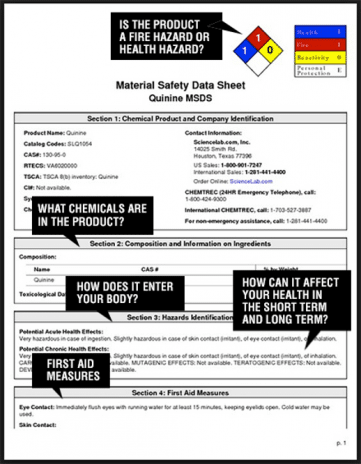Safety Data Sheets (SDS)
A safety data sheet (SDS) provides information about the hazards of a product and advice about safety precautions. An SDS is prepared by the chemical manufacturer for any chemical which presents a hazard to health and safety. It includes information about each chemical, covering the physical and environmental hazards, precautions for safe handling, storage and transportation of the chemical. Canadian Centre for Occupational Health and Safety (CCOHS) requires all employers to make SDS available to employees for any potentially harmful substance that may be handled in the workplace. Even when available, knowing how to read an SDS is a must for managers, supervisors and employees.

The information on an SDS sheet is organized into sections. The specific names of the section can vary from one supplier’s SDS to another but are generally include 16 sections as per the American National Standards Institute (ANSI) Standard for SDS preparation.
Let’s walk through each one:
- Identification: this section will include product name, other mean of identification (e.g. product family, synonyms, etc.), recommended use, restrictions on the use, Canadian supplier’s full name with address and phone number, and emergency contact number.
- Hazard Identification: this section provides information on hazard classification (class, category or subcategory) of substance or mixture or a description of the identified hazard for Physical or Health Hazards Not Otherwise Classified.
- Composition/Information on ingredients: this is section identifies the ingredient(s) of the chemical product identified on the SDS, including impurities and stabilizing additives.
- First-aid measures: First-aid measures by route of exposure such as inhalation, skin contact, eye contact and ingestion. Most important symptoms and effects such as acute or delayed as well as immediate medical attention and special treatment, if necessary.
- Fire-fighting measures: The First Aid Measures section describes actions to be taken immediately in case you are accidentally exposed to the material. The purpose of first aid is to minimize injury and future disability. In serious cases, first aid may be necessary to keep the victim alive.
- Accidental release measures: General instructions for responding to an accidental release or cleaning up a spill are provided in this section. Specific information, such as recommended absorbent materials for spill cleanup, may be included.
- Handling and storage: this section will include the information necessary for the safe handling of the material as well storage recommendations are also provided in the section.
- Exposure controls/ Personal protection: this section will provide information on control parameters, including occupational exposure limits and the source of those values such as appropriate engineering controls, individual protection measures.
- Physical and chemical properties: this section will provide the information on physical state, colour, odour, pH, melting/freezing point, flash point, flammability (solid, gas), vapour density etc.
- Stability and reactivity: This section of the SDS describes any conditions under which the material is unstable or can react dangerously and conditions that should be avoided.
- Toxicological information: This section of the SDS contains toxicity information, either for the ingredients of the product or the product as a whole. When reading about the effects of the material on animals, it is important to remember that the effects are not necessarily the same for people.
- Ecological information: this section contains information that is useful in evaluating the environmental impact of the material if it is released (e.g. toxicity to fish, birds, plants and microorganisms).
- Disposal considerations: in this section general waste disposal information will normally be included.
- Transport information: If there are special precautions necessary during shipment, they will be provided in this section.
- Regulatory information: Useful references to applicable health, safety and environmental laws and regulations may be provided, along with information on the regulatory status of the product.
- Other information: This section is used to provide supplementary information which the author of the data sheet considers important for the safe use of the material (e.g. label text, hazard ratings).
Use this guide with the Safety Data Sheets (SDS) applicable to your workplace. If you have any questions or concerns, reach out to our team and we will be happy to help! It issue important for employers and management to understand and follow Safety Data Sheets (SDS) so that you can best educate your employees to ensure a SAFE and HEALTHY workplace!
Contact Our Team!
2 Comments
Leave a Reply Cancel reply
How Can We Help You?
Contact us at JADA Solutions (HSE) Inc. to speak with one of our professionals!
Newsletter
What is Sick Building Syndrome? 🏢
Learn about some common causes, risk factors and prevention methods in our latest blog post:
#sickbuildingsyndrome #indoorairquality #iaq #hseblog
Did you know that March is Workplace Eye Safety and Wellness Month? 👀
Our latest blog post covers common risks & tips for optimal Eye Health and Safety. ✍
Learn more:
-
#eyehealth #eyesafety #eyewellness #healthandsafety #hse


[…] any hazardous product. Read the SDS for detail information about the hazardous product. (Check our “How to read SDS” blog). Moreover, do not use a product that is missing a label or label is not […]
[…] any hazardous product. Read the SDS for detail information about the hazardous product. (Check our “How to read SDS” blog). Moreover, do not use a product that is missing a label or label is not […]